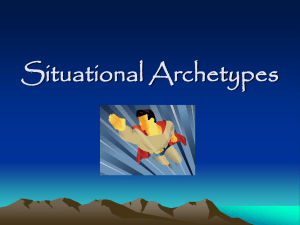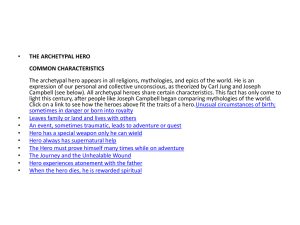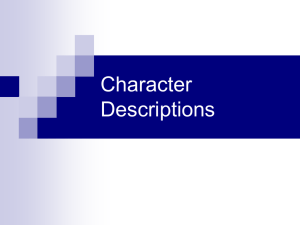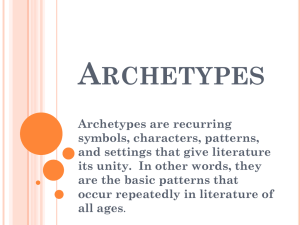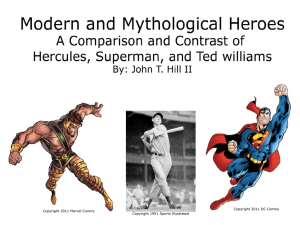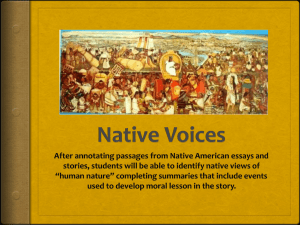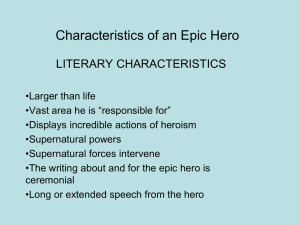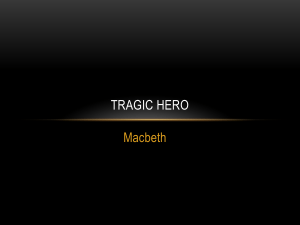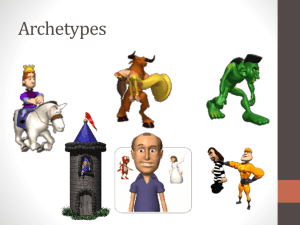Archetype symbols and examples
advertisement
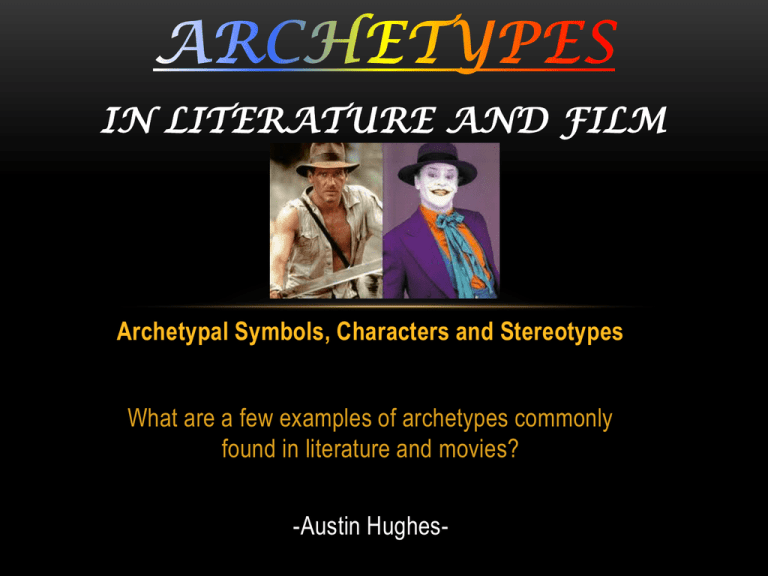
IN LITERATURE AND FILM Archetypal Symbols, Characters and Stereotypes What are a few examples of archetypes commonly found in literature and movies? -Austin Hughes- OBJECTIVE • Performance: Students will be able to locate examples of archetypal characters, symbols, and images. • Condition: Using these examples, students will identify patterns in archetypal usage and make suggestions regarding the author’s purpose of usage, and classify the examples into groups that represent their stereotype. • Criteria: The students will identify at least three archetypes and apply their knowledge to accurately classify each character to a particular stereotype and provide evidence for their decision. OVERVIEW • Brief history • “The Good Guys” • “The Bad Guys” • Activity (worksheet Hand-out) • Archetypal Colors and Symbols • Group Activity ETYMOLOGY • First used in English in 1540. • The word archetype derives from the Latin noun archetypum. • Meaning “Pattern, Model, Type” COMMON TYPES OF ARCHETYPES Protagonist Antagonist • The Hero • Villain • The Anti-Hero • The Trickster • The Mentor • The Shadow • The Willing Hero • Willing to undertake any quest courageously • The Unwilling Hero • Doubtful, passive, unwilling to journey • The Loner Hero • Able to overcome opposition alone • Tragic Hero • Have a tragic flaw that hurt them in the end EXAMPLES OF HEROES • The Willing Hero • Beowulf; King Arthur; Red Crosse Knight • The Unwilling Hero • Achilles, Hercules, Bilbo, Aragorn • The Loner Hero • James Bond; Superman; Indiana Jones • Tragic Hero • Romeo; Brutus; Hamlet; Macbeth TYPES OF MENTORS • The “Wise Old Man/Woman” • Possesses wisdom and experience • The Comic Mentor • Provides humorous advice • Continuing Mentor • Recurring character such as boss or best friend • Fallen Mentor • Have faced a similar crisis; provides warning EXAMPLES OF MENTORS • The “Wise Old Man/Woman • Yoda, Van Helsing, Gandalf • The Comic Mentor • Glenda the Witch, Fairy Godmothers, • Continuing Mentor • Alfred, Mentor, Una • Fallen Mentor • Haymitch, Yoda ANTI-HEROES • Generally oppressive, pessimistic, and/or corrupt. • Motivated by own personal desires • Reluctant • Classic Anti-Hero • Frankenstein, Achilles, Hercules • The Tragic Anti-Hero • Jack Sparrow, Darth Vadar, Han Solo HEROES & THEIR MENTORS • Heroic characters typically have a guide that enlightens them near the beginning of their journey and/or in times of hardship. • Frodo had Gandalf • Batman had Alfred • Luke Skywalker had Ben Kanobi • Mina Murray had Van Helsing “THE BAD GUYS” THE VILLAIN • The foil of the hero • Dueling personalities, tricky • Classic Villains • Moriarty, Long John Silver, The Dragon • Modern Villains • The Joker, Hannibal Lector THE SHADOW • Hero’s foil (Mirror Image of the hero) • Dueling personalities, tricky • The arch enemy • Classic Example • Mr. Hyde, Duessa • Modern Example • The Dark Sith, THE TRICKSTER • Seek to humiliate or outwit the Hero • Antics cause the adventure • Cunning and foolish • Classic Tricksters • Archimago, Reynard the Fox • Modern Tricksters • Bugs Bunny, The Riddler, the Joker OTHER ARCHETYPES • The CHIEF - a dynamic leader, he has time for nothing but work The BAD BOY - dangerous to know, he walks on the wild side The BEST FRIEND - sweet and safe, he never lets anyone down The LOST SOUL - a tormented being, he lives in solitude The CHARMER - a smooth talker, he creates fantasies The PROFESSOR - coolly analytical, he knows every answer The WARRIOR - a noble champion, he acts with honor During Reading Activities ARCHETYPAL COLORS • Black: Death/mourning, emotional darkness, hidden desires/instincts, un-enlightenment. Black: darkness, chaos, mystery, the unknown, death, wisdom, evil, melancholy. • Blue: The color of the spirit, the spiritual, the heavenly, the divine, intuition, inspiration. Has the association with the unconscious and feminine qualities. • Green: In positive terms, Mother Nature, fertility, hope, renewal, health, youth, harmony, prosperity. The color of sensual and spiritual passion. • Orange: Balance, creative expression, pride and ambition, cruelty, ferocity, luxury. As the color of fire, can represent burning away impurities. ARCHETYPAL COLORS • Purple: The color of royalty, imperial power, pride, justice, intuition, wisdom, truth. As a blend of red and blue, it is the color of authority/ power and the wisdom to know how to use it. • Red: Blood, life, life-force; embarrassment, anger; fire, lust, passion. Associated with activity, energy, courage, will power, and war. • White: Purity, holiness, sacredness, redemption, mystical enlightenment, innocence, joy, light and life it is transcendent perfection. It signifies the union of opposites to form a whole as well as the symbolic death of transformation and renewal. • Yellow: The sun, illumination, intellect and generosity, maturity. The color of fire and thus the purification of flame. Yellow: enlightenment, wisdom. AFTER READING ACTIVITY • Each group will choose an archetype: (Hero, villain, mentor, or trickster.) List 3 physical characteristics List 3 personality traits and/or ideals Describe the archetype’s typical purpose in the story. Provide 3 famous examples of your archetype in literature HOMEWORK ASSIGNMENT • Applying the information from today’s lesson, create a unique set of archetypal characters (a hero, a mentor, and a villain) and write a short story using your characters. • Story must be at least one page in length • Contain an introduction, problematic situation, and a conclusion explaining the hero’s triumph or defeat. • Ticket in the door: • Place completed short story in box beside the door. GEORGIA STANDARDS • ELA10RL2: The student identifies, analyzes, and applies knowledge of theme in literary works and provides evidence from the works to support understanding. • E. I. Archetypal Characters (i.e., hero, good mother, sage, trickster, etc.) ii. Archetypal Patterns (i.e., journey of initiation, search for the father, etc.) iii. Archetypal Symbols (i.e., colors, water, light/dark, etc.)
